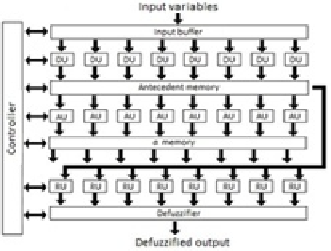Information Technology Reference
In-Depth Information
The paper is organized as follows. Section 2 describes the processor architecture.
Section 3 describes the simulation and results. Conclusion is presented is section 4.
2
Architectural Design of Processor
Fig. 1 depicts the fuzzy processor architecture. The processor has a controller, eight
detection units (DU), eight antecedent units (AU), eight rule units (RU), a defuzzifier,
antecedent memory, ʱ-memory and an input buffer, whose details are given in the
following subsections. Pipelining and parallelism have been employed in the architec-
tural design to speed up the computation and increase throughput.
The number of fuzzy variables,
n
F
used in the architecture is 16 and the number of
linguistic variables,
n
L
is 16. The maximum number of rules,
n
R
is 256, with each rule
having one consequent. Each of the fuzzy variables is 16 bits wide. Thus the universe
of discourse,
d
U
is 65536 values. The number of membership degrees,
n
T
for the lin-
guistic sets is 256. The fuzzy sets taken into consideration are convex.
Fig. 1.
Processor Architecture
Fig. 2.
Detection Unit
2.1
Detection Unit
The detection unit is used for finding the antecedents with a positive degree of truth
i.e. having non-null intersection with the fuzzy input variables. The detection unit gets
the input variables from the input buffer.
Intersection or overlap between the respective supports of the fuzzy sets is
checked. Let
F
ik
be the fuzzy set for the
k
th (
k
= 1,2, …,
n
L
) linguistic variable of the
input
X
i
(
i
= 1,2, …,
n
F
)
. The indicator variable
a
ik
gets the value 1 or 0 depending on
whether overlap exists or not between
F
ik
and the input fuzzy set
X
i
, and gets stored in
the antecedent memory.
Fig. 2 shows the architectural design of the detection unit. Each detection unit has
two memories M
1
and M
2
. M
1
is used to store the supports for the linguistic variables
and M
2
stores the supports for the fuzzy inputs. Since the fuzzy sets are convex, the
supports can be represented by the left and right end-points. Both the end-points
of a fuzzy set are stored in one word. M
1
contains 32 words, each having a width of
16*2 = 32 bits. M
2
contains 2 words having same width as M
1
.


